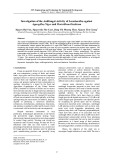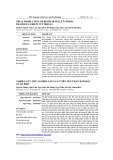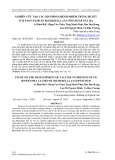
Int.J.Curr.Microbiol.App.Sci (2020) 9(11): 1053-1058
1053
Original Research Article https://doi.org/10.20546/ijcmas.2020.911.123
In vitro Studies on Potentiation of Enrofloxacin by Phytochemicals
Srividya Gullapudi1*, G. S. Rao1, P. Ravikumar1, Muralidhar Metta2 and V. Ramadevi3
1Department of Veterinary pharmacology & Toxicology CVSC, Proddatur,
YSR Kadapa district, Andhrapradesh-516360, India
2Department of Animal Genetics and Breeding, 3Dept of Veterinary Pathology,
SriVenkateswara Veterinary University, Tirupati, India
*Corresponding author
A B S T R A C T
Introduction
Bacterial infections are one of the major
clinical implications observed in routine
veterinary practice. From the dawn of
civilisation so many drugs, antibiotics came
into role to treat bacterial infections. Even
after the discovery of many antibiotics
starting from penicillins to quinolones,
treating the bacterial infections has became a
challenging issue till to date due to the
emergence of resistance by the bacteria to
antibacterial agents. Antibiotics and other are
used as growth promoters, coccidiostats and
various purposes for the production of animal
meat for human consumption.
Due to over the counter usage, indiscriminate
application, failure of following the dosage
regimen will sensitize the bacteria to develop
resistance. Among several means of
resistance development by the bacteria, efflux
mediated resistance is of prime importance.
International Journal of Current Microbiology and Applied Sciences
ISSN: 2319-7706 Volume 9 Number 11 (2020)
Journal homepage: http://www.ijcmas.com
Enrofloxacin, an antimicrobial fluoroquinolone is most commonly used against majority of
gram negative bacterial and mycoplasma infections in majority of livestock. Indiscriminate
usage of enrofloxacin in clinical practice leads to resistance development to this quinolne
drug. Among the various pathways of resistance, efflux pump mediated drug resistance is
one of the important pathways identified in the recent past. Phytochemicals namely,
theobromine, glycyrrhetenic acid and glycyrrhizic acid and capsaicin were identified as
efflux pump inhibitors. Phytochemicals which possess efflux pump inhibitory activity if
combined with classical antimicrobial agents reduces the development of resistance and
also improves their therapeutic efficacy. Interaction between enrofloxacin, and capsaicin,
theobromine, glycyrrhetenic acid and glycyrrhizic acid were studied by determining MIC
and MBC against E.coli, S.aureus, K.pneumoniae and P.aureginosae following CLSI
guidelines. There is a significant decrease in MIC and MBC values of enrofloxacin in the
presence of phytochemicals. In conclusion, Synergisitic interaction of efflux protein
inhibitory phytochemicals capsaicin, theobromine, glycyrrhetenic acid and glycyrrhizic
acid with enrofloxacin was noticed in minimum inhibitory concentration (MIC) and
minimum bactericidal concentration.
K e y w o r d s
Enroloxacin,
Capsaicin,
Theobromine,
Efflux pump, MIC
Accepted:
10 October 2020
Available Online:
10 November 2020
Article Info

Int.J.Curr.Microbiol.App.Sci (2020) 9(11): 1053-1058
1054
Efflux proteins are present on bacterial cell
membranes whose role is extrusion of the
antibacterial agents inside the bacterial cell to
outside, thereby enhancing their survivability
(Borges Walmsley et al., 2003).
Antibiotic resistance is a one health challenge
globally. de Kraker et al., (2016), reported
that 10 million people will die due to AMR by
2050, if the challenge was not encountered.
Enrofloxacin, a fluoroquinolone antimicrobial
is effective against a broad spectrum of gram-
positive and gram-negative bacteria.
Resistance has developed to this agent
because of indiscriminate application
(Adamson et al, 2015; Gouvea et al, 2015). It
has also been reported that combination of
putative efflux pump inhibitors trimethoprim
and sertraline with levofloxacin resulted in
enhanced therapeutic efficacy of levofloxacin
a quinolone antimicrobial drug against
P.aeruginosa that over expresses Nex-AB-
Oprm, MexCD-OprJ and MexEF OprM
efflux pumps (Adamson et al, 2015).
Perusal of available literature indicated that
there are no reports of usage of
phytochemicals that possess efflux inhibitory
activity in combination with enrofloxacin to
reduce its resistance to microbes are available.
Keeping the background in view, the present
study was designed to determine the
antibacterial action of enrofloxacin alone and
in combination with phytochemicals
capsaicin, theobromine, glycyrrhetenic acid
and glycyrrhizic acid against S. aureus ATCC
25923, E.coli ATCC 25922, K. pneumoniae
ATCC 700603 and P. aeruginosa ATCC
27853.
Materials and Methods
Chemicals
Enrofloxacin, Capsaicin, glycyrrhizic acid,
glycyrhetenic acid and theobromine were
procured from Sigma-Aldrich, St. Louis, MO,
USA. Mueller-Hinton Broth was obtained
from M/s Hi Media Laboratories Pvt. Ltd.
Mumbai, India. Magnesium chloride was
obtained from M/S Fisher Scientific, Mumbai,
India and calcium chloride was from M/s SD
Fine - Chem Ltd, Mumbai, India. p-
Iodonitrotetrazolium (INT) was procured
from M/s SRL, Mumbai, India. S. aureus
ATCC 25923, E. coli ATCC 25922, K.
pneumoniae ATCC700603 and P. aeruginosa
ATCC27853 cultures were procured from
Principal investigator, RKVY project, Dept of
Veterinary pharmacology and toxicology,
NTR CVSc, Gannavaram, SVVU.
Determination of Minimum Inhibitory
Concentration (MIC)
Preparation of 0.5 McFarland turbidity
standards
Stock solutions of 0.18 M (0.36 N) H2SO4
(1% v/v) and 0.048 M BaCl2 (1.175% w/v
BaCl2•2H2O) were prepared. With a constant
stirring to maintain a suspension, 0.5 mL of
the BaCl2 solution was added to 99.5 mL of
the H2SO4 stock solution. The correct density
of the turbidity standard was verified by
measuring absorbance using a
spectrophotometer with a 1 cm light path and
matched cuvettes. The absorbance at 625 nm
was 0.08 to 0.13 for the 0.5 McFarland
standard. 5 mL aliquots of BaSO4were
transferred into screw cap tubes of the same
size as those used for standardizing the
bacterial inoculum (CLSI, 2012).
Preparation of supplements and media
cation stock solutions
Stock solution of 10 mg of Mg++/ml was
prepared by dissolving 8.36 g of MgCl2•6H2O
in 100 ml of deionized distilled water and
stock solution of 10 mg of Ca++/ml was
prepared by dissolving 3.68 g of CaCl2• 2H2O

Int.J.Curr.Microbiol.App.Sci (2020) 9(11): 1053-1058
1055
in 100 ml of deionized distilled water. They
were sterilized by membrane filtration and
stored at 2 to 8°C (CLSI, 2012).
Preparation of Cation-Adjusted Muller-
Hilton Broth (CAMHB)
Two hundred ml of Muller-Hilton Broth was
prepared according to manufacturer’s
recommendations, autoclaved and chilled
overnight at 2 to 8°C. To this chilled broth,
0.2 ml of MgCl2 stock solution was added
with constant stirring followed by addition of
0.4 ml of CaCl2 stock solution so that the final
concentration of Mg and Ca ions in the broth
was 10 and 20 mg/l, respectively. The pH of
the broth after addition of cations was 7.2 to
7.4.
MIC by broth microdilution method
The broth microdilution method was used to
determine the MIC of enrofloxacin against
S.aureus ATCC 25923, E. coli ATCC25922,
K. pneumoniae ATCC700603 and P.
aeruginosa ATCC27853. Working standard
of 1 µg/ml enrofloxacin was prepared by
diluting the stock solution with normal saline.
Two-fold serial dilution of enrofloxacin in
CAMHB was prepared in 96 well microtiter
plate, so that final volume in each well was
100 µl. The bacterial culture incubated in
CAMHB at 37±1°C for 6 to 8 h was taken
and its turbidity was adjusted to 0.5
McFarland turbidity standard (1 X 108
CFU/ml) which was then diluted 1:20 in
CAMHB. When 0.01 ml of this suspension
was inoculated into the broth, the final
concentration of bacteria was approximately 5
X 105 CFU/ml (range 2 - 8X 105 CFU/ml or 5
X 104 CFU/well). Each plate was sealed
properly to prevent drying during incubation.
Inoculated microdilution trays were then
incubated at 35±2°C for 16 to 20 h in an
ambient air incubator.
MIC End Point
The MIC is the lowest concentration of
antimicrobial agent that completely inhibits
growth of the organism in the microdilution
wells as detected by the unaided eye or
microplate reader (MultiskanTM GO,
ThermofisherscientificTM) to discern growth
in the wells.
The amount of growth in the wells containing
antimicrobial agent was compared with that
of growth-control wells (no antimicrobial
agent) used in each set of tests. Alternatively,
bacterial growth and inhibition was detected
by adding 25 µl of INT to each well and
incubation for 30 min at 35±2°C. INT is
reduced to a red formazan compound by
biologically active organisms. Bacterial
growth was considered to be inhibited when
the solution in the well remained clear.
Solvent controls and growth controls were
included in each experiment (CLSI, 2012).
Determination of Minimum Bactericidal
Concentration (MBC)
The minimum concentration of the drug
required to kill >99.9% viable organism after
incubation for a fixed length of time (24 hr)
under a given set of conditions is known as
minimum bactericidal concentration (MBC).
The wells that didn’t show any visible growth
of the organism on MIC microtiter plate were
transferred to Meuller Hilton Agar. Then, the
plate was incubated for 24 hours at 37°C
(CLSI, 2012). MBC values were taken at the
lowest concentration that does not show any
growth in subculture agar.
Results and Discussion
The mean MIC, MBC values of enrofloxacin
alone and in the presence of phytochemicals
were depicted in table 1 and 2.

Int.J.Curr.Microbiol.App.Sci (2020) 9(11): 1053-1058
1056
Table.1 Minimum Inhibitory Concentration (MIC, µg/ml)) of enrofloxacin alone and in
combination with efflux protein inhibitors against the selected bacteria
Name of the test
compound
S. aureus
ATCC25923
E. coli
ATCC25922
K. pneumoniae
ATCC700603
P. aeruginosa
ATCC27853
Enrofloxacin
0.202
0.020
1.650
2.433
Capsaicin +
Enrofloxacin
0.090
0.012
0.266
0.404
Theobromine+
Enrofloxacin
0.110
0.012
0.258
0.450
Glycyrrhetenic acid
+ Enrofloxacin
0.041
0.012
0.404
0.450
Glycyrrhizic acid+
Enrofloxacin
0.11
0.012
0.404
0.450
The values are expressed as mean of six replications
Table.2 Minimum Bactericidal Concentrations (MBC, μg.ml-1) of Enrofloxacin alone and in
combination with Efflux protein inhibitors against the selected bacteria
Name of the test
compound
S. aureus
ATCC25923
E. coli
ATCC25922
K. pneumoniae
ATCC700603
P. aeruginosa
ATCC27853
Enrofloxacin
0.403
0.040
3.300
4.867
Capsaicin+
Enrofloxacin
0.181
0.024
0.532
0.808
Theobromine+
Enrofloxacin
0.220
0.024
0.517
0.900
Glycyrrhetenic
acid+Enrofloxacin
0.081
0.024
0.808
0.900
Glycyrrhizic
acid+Enrofloxacin
0.220
0.024
0.808
0.900
The values are expressed as mean of six replications
The interaction of enrofloxacin and
enrofloxacin with efflux protein inhibitors viz.
capsaicin, glycyrrhizic acid, glycyrrhetenic
acid and theobromine with regards to MIC
and MBC was explored against E. coli ATCC
25922, S. aureus ATCC 25923, K.
pneumoniae ATCC 700603 and P.
aeruginosa ATCC 27853 strains and were
tabulated in table 1 and 2. The MIC value of
enrofloxacin was 0.02 μg.ml-1 against E. coli
ATCC 25922 that was lowered (0.012
μg.ml-1) in presence of capsaicin, glycyrrhizic
acid, glycyrrhetenic acid and theobromine
resulting in 40% improvement in MIC against
E. coli. The MIC value of 0.2 μg.ml-1 for
enrofloxacin alone was observed against S.
aureus ATCC 25923 which was lowered by
55% in the presence of capsaicin and 45% in
presence of glycyrrhizic acid, glycyrrhetenic
acid and theobromine. Similarly, it was
shown that capsaicin potentiates enrofloxacin
against S. aureus due to the inhibitory effect
on NorA efflux pump of S.aureus (Kalia et
al., 2012). The MIC value of enrofloxacin
against K. pneumoniae ATCC 700603 was
1.650 μg.ml-1which was reduced by 83.8% in
the presence of capsaicin and was reduced to
75% in the presence of glycyrrhizic acid,

Int.J.Curr.Microbiol.App.Sci (2020) 9(11): 1053-1058
1057
glycyrrhetenic acid and theobromine. The
MIC value of enrofloxacin against P.
aeruginosa ATCC 27853 was 2.433 μg.ml-1
which was reduced to 83% in the presence of
capsaicin, glycyrrhizic acid, glycyrrhetenic
acid and theobromine. It was also reported
that phytochemicals like plumbagin, NDGA,
and shikonin were able to increase
susceptibility of bacterial organisms to
antibiotics and toxic compounds and were
also the most efficient in inhibiting AcrB-
mediated substrate efflux in bacteria (Ohene-
Agyei et al., 2014).
The MBC value of enrofloxacin against E.coli
ATCC 25922 was 0.041μg.ml-1. The MBC
values of enrofloxacin alone and in the
presence of efflux protein inhibitors was
presented in table 2. The MBC of
enrofloxacin against E.coli was reduced to
0.024 μg.ml-1 in the presence of capsaicin,
glycyrrhizic acid, glycyrrhetenic acid and
theobromine. The MBC value of enrofloxacin
against S.aureus ATCC 25923 was 0.403
μg.ml-1, which was reduced to 0.181 μg.ml-1in
the presence of capsaicin and to 0.220 μg.ml-
1in the presence of glycyrrhizic acid and
theobromine. The MBC value of enrofloxacin
against K.pneumoniae ATCC 700603 was
3.300 μg.ml-1which was reduced to 0.532
μg.ml-1in the presence of capsaicin and was
reduced to 0.517 μg.ml-1 in the presence of
theobromine. The MBC value of enrofloxacin
was reduced to 0.808 μg.ml-1 in the presence
of glycyrrhizic acid and glycyrrhetenic acid.
The MBC value of enrofloxacin against
P.aeruginosa ATCC 27853 was 4.867 μg.ml-1
which was reduced to 0.808 μg.ml-1 in the
presence of capsaicin and to 0.900 μg.ml-1 in
the presence of glycyrrhizic acid,
glycyrrhetenic acid and theobromine. The
results together suggest that the presence of
efflux protein inhibitors enhances the
bactericidal effect, which may be due to their
efflux protein inhibitory potential; as a result
they indirectly increase the intracellular
concentration of the antimicrobial agent.
Based on the above results it can be
concluded that phytochemical s as such may
not show antibacterial action comparable to
antibiotic enrofloxacin, but in combination
they enhanced the antibacterial activity which
can be utilised to reduce the amount of
antibiotic required to produce the therapeutic
effect.it can reduce the resistance
development as well as cost of therapy.
References
Adamson DH, Krikstopaityte V and Coote PJ.
2015. Enhanced efficacy of putative
efflux pump inhibitor/antibiotic
combination treatments versus MDR
strains of Pseudomonas aeruginosa in a
Galleria mellonella in vivo infection
model. Journal of Antimicrobial
Chemotherapy. 70 (8):2271-8.
Borges Walmsley MI, McKeegan KS and
Walmsley AR. 2003. Structure and
function of efflux pumps that confer
resistance to drugs. The Biochemical
journal 376:313-38.
deKraker ME, Stewardson AJ and Harbarth S.
2016. Will 10 million people die a year
due to antimicrobial resistance by
2050? PLoS Med. 13: e1002184
Gouvea R, dos Santos HC, de Aquino FF and
Pereira AVL de. 2015.
Fluoroquinolones in industrial poultry
production, bacterial resistance and
food residues: a review Brazilian
Journal of Poultry Science Rev. Bras.
Cienc. vic. vol.17 no.1 Campinas.
Kalia NP, Mahajan P, Mehra R, Nargotra A,
Sharma JP, Koul S and Khan IA. 2012.
Capsaicin, a novel inhibitor of the
NorA efflux pump, reduces the
intracellular invasion of
Staphylococcus aureus. Journal of
Antimicrobial Chemotherapy 67:2401–
2408.
NCCLS. National Committee for Clinical
Laboratory Standards, Approved
standard M7-A5. 2000. Methods for



![Đề cương môn Vi sinh vật thú y [chuẩn nhất]](https://cdn.tailieu.vn/images/document/thumbnail/2025/20250414/trantrongkim2025/135x160/1263896842.jpg)






















